The 6 Best USB Audio Interface Tools for Podcasts
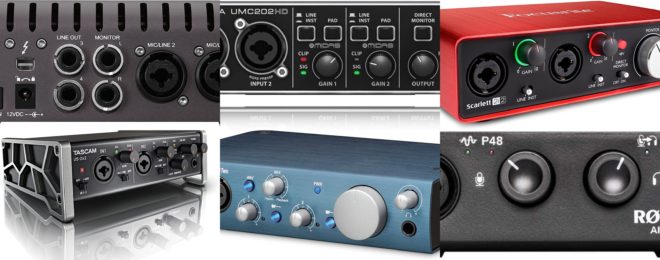
Fulfilling a similar function as an audio mixer in some ways, a USB audio interface can allow you to connect any microphone to a computer or iPad to record audio files and handle multiple tracks at once. USB audio interfaces vary in quality, features and input options but will almost always give you a better sounding audio file than recording with a microphone that connects directly to your computer with a USB. If you are deciding between purchasing a mixer and a USB audio interface, remember that a mixer does not actually record your audio and would still need to be connected to a laptop or other recording device, so in some cases an audio interface can be advantageous.
While many computers do have good internal built-in sound cards, these external devices are specially built to capture robust audio and have mic-preamps built into the XLR cable inputs that will get you better sounding audio than an XLR mic typically does. These interfaces vary a lot in size, price and function and the right USB audio interface will vary based on what you need, how many inputs and outputs you are looking for and what mics you are using.
While there are audio interfaces built for a single microphone, you will probably want at least two XLR inputs just in case the option to add a second mic ever comes up. If you are already recording with two mics, look to purchase a four input interface for the same reason. Unlike audio mixers which can be large in size and for many podcasters, feature controls you likely will not touch, the best USB audio interfaces are still relatively small and simple to control.
One thing that you may notice when shopping for audio interfaces is that less options are available, and most come from well-regarded brands. This makes the shopping experience much easier than buying microphones, headphones or a mixer, but also means that most of the top options are very similar in features. You will typically see a gain control for each mic input, as well as an output control and a control for the level going into your headphones. Beyond that, other controls or features are less essential for podcasters recording voices.
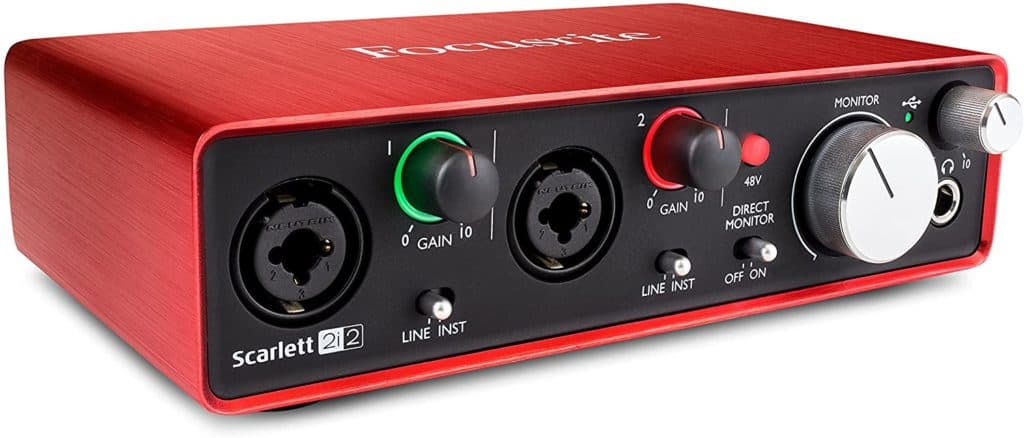
Focusrite Scarlett 2i2
The 2i2 from Focusrite is an incredibly popular, compact audio interface with two XLR inputs, 48V power, direct monitoring and a headphone jack for monitoring. The interface is powered over USB 2.0 and both the XLR inputs and the headphone jack have their own gain control for precise audio levels.
The interface works with iOS, macOS, and Windows devices, as will most newly released interfaces you encounter. At just 1.32 pounds, it is incredibly lightweight and compact and in addition to being very easy to set up, it is a great option for recording on the go.
Focusrite’s Scarlett line of interfaces also includes the Scarlett Solo for single mic recording, but the price difference between the two is so slim that in most cases it makes sense to go with the 2i2.
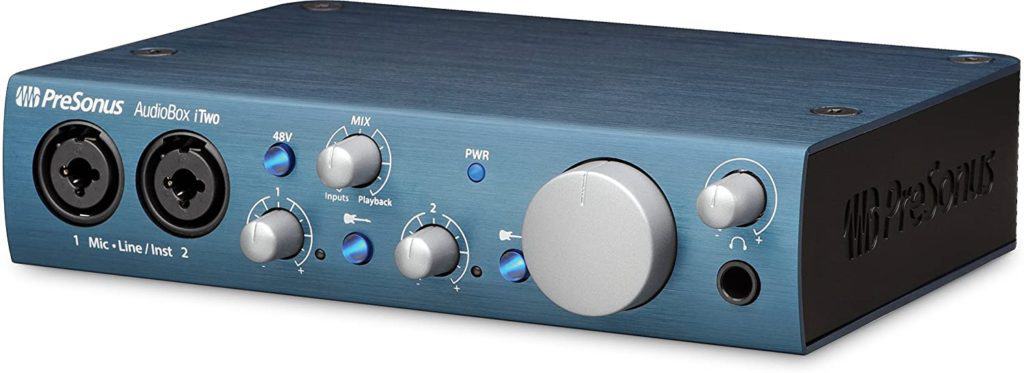
Presonus AudioBox iTwo 2×2 USB 2.0/iOS Interface
Very similar to the 2i2 from Focusrite in size, build and features, the Presonus AudioBox iTwo is another great option to consider if you are looking for a compact interface with two XLR inputs. The front panel design is slightly less intuitive than the Scarlett 2i2 with controls all together, rather than next to their corresponding input, but ultimately both provide a very similar experience.
The AudioBox also links directly with Capture Duo for iPad, a dedicated app that allows for one-tap recording. For podcasters who are not already working with a recording software or app they like, this could be one small advantage. Of course, there is also the difference in color, with the Scarlett interface being a red color and Presonus AudioBox a metalic blue.
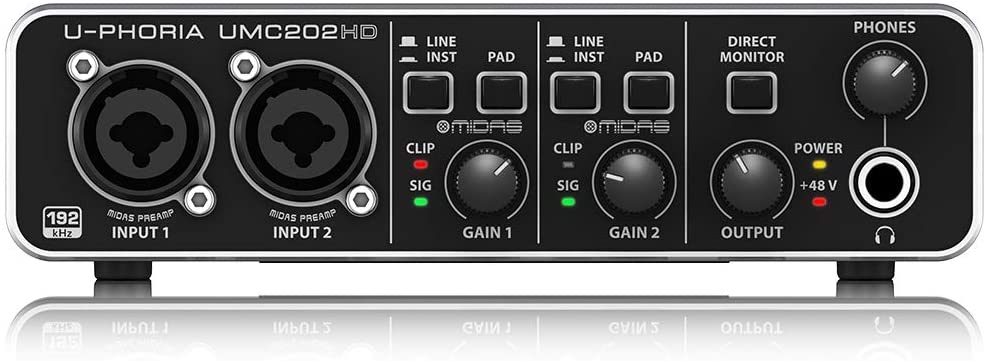
Behringer U-Phoria UMC202HD
Behringer is well-known for their variety of audio recording equipment, including a great series of mixers. Their U-Phoria interface is also incredibly high-regarded, with two mic preamps that include +48 Volt phantom power for condenser microphones. The device works with both Mac and PC and includes access to Tracktion, an easy-to-use software for recording, editing, mixing and sharing audio files.
If you are just looking for a one-channel interface, consider the Behringer’s U-Phoria 1x XLR, which is typically priced at less than $50. Typically, one-channel and two-channel interfaces are priced closer, but here the smaller interface is just as good of an investment. There is also a four-channel interface priced at $178.00 and a large eight-channel interface at just over $300.00. It can sometimes be advantageous to purchase a mixer with more channels than you think you will need, to give you flexibility down the road, so consider these mixers if you think you may need more than two inputs.

Tascam US 4×4 USB Audio Interface
If you are looking for a well-priced four channel interface, consider this option from Tascam. While all of Focusrite and Behringer do offer four channel options of their devices as well, Tascam’s is priced a bit lower and is one of the simplest four channel interfaces to use.
Each input has a gain control adjacent to it, as does the headphone jack. The gain controls also have a slight angle at the front, which can make them a bit more comfortable to use and view if you are working at a computer with your interface lower down on a desk. This is helped even more by the fact that the entire interface sits at an angle as well, making the front controls slightly more exposed. The interface comes with two digital audio workstations to choose from, Cakewalk SONAR X3 LE and Abelton Live Lite 9, and is compatible with other editing softwares too.

Rode AI-1 Single Channel USB Audio Interface
For a well-made, easy to use, single channel interface look no further than the Rode AI-1. While it is priced higher than some other single channel interfaces, the device is super compact and newly released to feature a USB-C port on the back instead of USB 2.0 or 3.0. The AI-1 works great with Rode mics, but the 48V phantom power and class compliant build (meaning you do not need to install any drivers) makes it a great fit for any other mics you might have as well.
The real selling point of the AI-1 is the sound quality and the fact that it is not compromised by the small, minimal design. At just 1.1 pounds with an incredibly small footprint, this is a great interface to keep permanently on a desk or workstation.
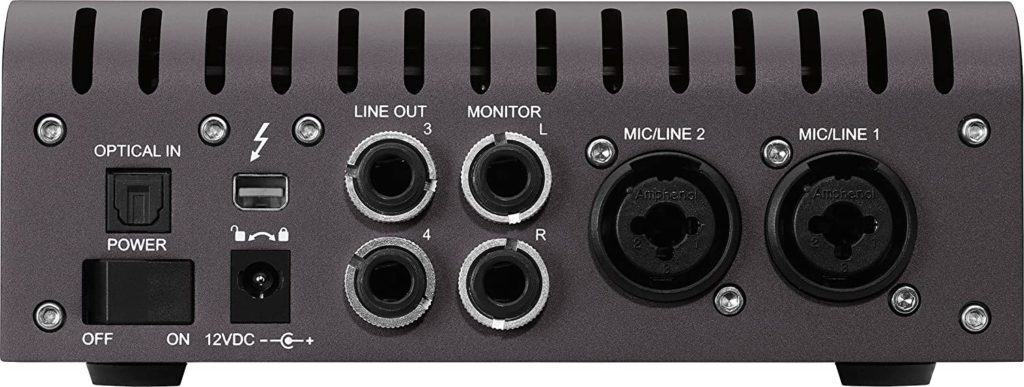
Universal Audio Apollo Twin MKII Duo
An ultra-premium audio interface that stands out from the pack because of the design and the price point is the Universal Audio Apollo Twin. This interface is really meant for music recording and while audio engineers love it, an interface of this quality will not improve your podcast recording. That being said, it features beautiful design, world-class 24-bit/192 kHz audio conversion and top-notch build quality. Though it’s quite expensive, unless your podcast features live vocal performance or instrumentation, it may be excessive.













Comments
Comments are closed.